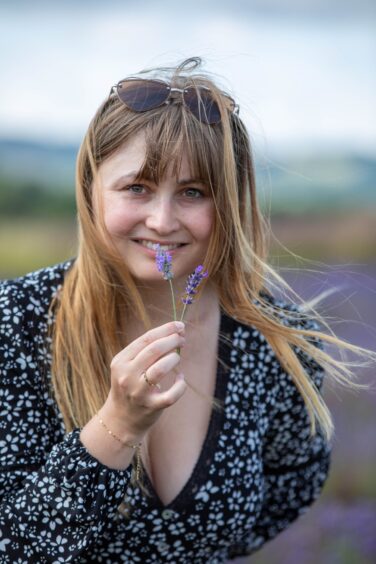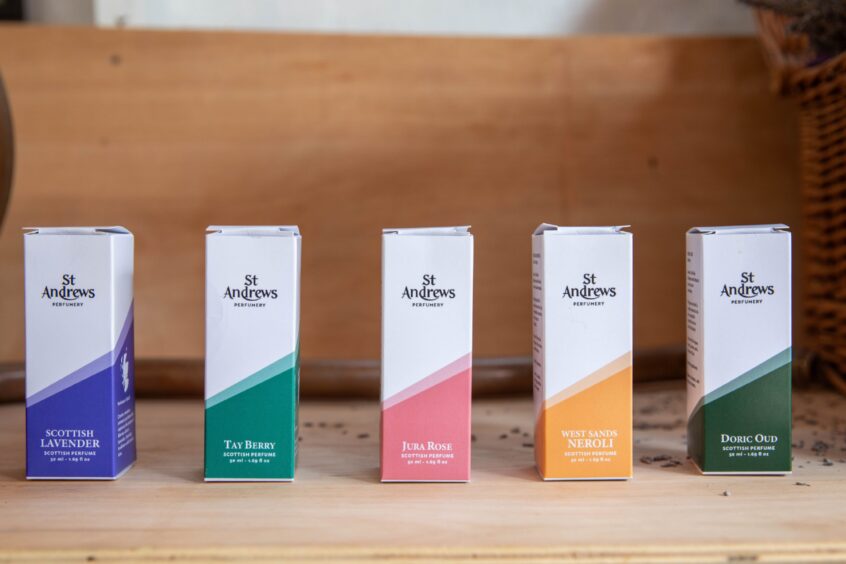Strolling through 8,000 blooms of vibrant, fragrant lavender on a sunny day in Kinross, it’s easy to feel like I’m somewhere on the Spanish coast.
But Tarhill Farm, located just past Milnathort, is the home of Scottish Lavender Oils – and it’s the only lavender oil production base in Scotland.
It’s also a wee haven of sleepy summer for just over four weeks each year, when the plants are in bloom and the field is open to the public, with hourly tours showing visitors how the farm’s high-quality lavender oil is made.
And on the day I visit, the farm is showing its very best colours.
The sun has been wheeled out from behind the clouds to brighten the deep purple and muted violet flowers of the English and French lavender plants, whose beautiful blooms attract pollinators and influencers in equal measure.
Lavender farm is influencer’s paradise
To be fair, it’s a particularly Insta-worthy spot. No wonder there’s been multiple proposals and even a DIY wedding here.
As I wait to take part in the tour, I wander around the fields, where lavender blooms laden with bees are stacked in neat rows up the hillside.
A serene-looking influencer dressed from head-to-toe in crisp white linen films herself doing Tai Chi against the calming backdrop, while many well-trained boyfriends snap photos from all angles as their sundress-clad girlfriends frolic photogenically.
Such is modern life. I join in the photo-taking fun, but quickly discover that despite the skills of our long-suffering photographer Kenny, I’m no natural model. Oh well.
Before I know it, it’s time for the tour, which sets off from the top of the hill every hour, on the hour. It’s a busy one, with about 30 people tagging along to hear about the workings of Scottish Lavender Oils.
And though it’s her first season on the farm, tour guide Marcella Beban, 19, does an excellent job at bringing Tarhill’s story to life.
Tarhill Farm is rare lavender hotspot
“The farm was bought 10 years ago by the Irwin family,” explains Marcella, a St Andrews University student based in nearby Milnathort.
“It was extremely ambitious to try and grow lavender, as we’re one of the only lavender farms in Scotland.”
Typically a Mediterranean plant, lavender requires lots of sunlight, fast-draining soil and low humidity. It doesn’t typically like the cold, and won’t survive in damp, shady conditions, which means that historically, it has been hard to grow in Scotland in large quantities.
But as it turns out, Tarhill Farm has a rare combination of qualities which make it possible for lavender plants to not only grow, but to thrive – a fairly steep hillside, for natural drainage, a south-facing field, affording plenty of sunlight, and a man-made lochan, which attracts lots of wildlife and biodiversity, including bees, birds and even hares.
Combine this with the effects of climate change in recent decades, and lavender has been able to flourish – which was lucky, explains Rory Irwin, son of farm owner Graham.
Scottish Lavender Oils is a family affair
“It started off as a sort of sustainability retirement project for my dad, he was in the electrical business,” explains Kinross native and Oxford University graduate Rory.
“He always wanted to do something like that when he retired. This was not a brilliant part of the field, the really steep slope wasn’t suitable for normal arable farming.
“So we divided the big field into little sections that then let us put the fallow and the wildflowers in. Then all that remained was a really steep slope, and it just so happened to be perfect for lavender.”
Five years ago, the family opened the Kinross farm to visitors to see the spectacle of the field in bloom.
Of course, it’s not just the sight that attracts thousands of visitors over the five-week opened period each summer – it’s the smell too.
Take a whiff of the purple stuff at Kinross
Free of any insecticides or artificial chemicals, the lavender at Tarhill is all grown using just rainwater and sunlight, with the only biological control taking the form of frothy ‘spittle beetles’ which can be spotted on the plants.
This means there’s no interfering smells when, guided by Marcella, the group is instructed to take a head of each type of lavender – English and French – and to crush the flower between thumb and forefinger to release the scented oil.
Taking a whiff, I find the English to be delicate and light, while the French lavender is much stronger and sharper-smelling.
Marcella says this is because French lavender contains a lot more camphor, which is believed to contain nerve-stimulating and pain-relieving qualities.
The more you know!
Just 10 litres of oil per year from farm
After a good old sniff-session, it’s off the barn where the lavender oil is distilled in a huge, 200-litre copper still – after Rory and Graham harvest it by hand, using a traditional sickle.
“It takes a huge amount of work,” admits Rory. “People maybe don’t realise. But it’s really just the three of us – me, my dad and a friend from the village.”
To make the lavender oil, the Tarhill team will cut about 150-200 blooms, and feed the entire plant (stem and flower) into the chamber of the still.
Heated with a traditional gas flame, the kettle will be turned on, and the lavender vapour will be released, then distilled back down through the cooling pipe into its component parts – hydrosol, or lavender water, and the more sought-after lavender essential oil.
Marcella reveals that in one 14-minute run, the blooms will yield just 100ml of oil. And over the course of the entire season, only 10 litres of oil will be produced, making Scottish lavender oil an extremely scarce product.
When passing around a bottle of the collected liquid, it’s eye-opening to see the tiny golden slick of oil atop a large run-off of hydrosol.
The oil can be used in massage, aromatherapy and diffusers. It’s used in Tarhill’s St Andrews Perfumery, and is sold wholesale only to Scottish cosmetics company Utan.
And the hydrosol can be used as room spray, clothing spray or body spray, meaning nothing is wasted from the distilling process.
But why do it so labour-intensively, with such little return, if Tarhill has the monopoly on lavender farming in Scotland?
Cleaning properties of copper still
Marcella explains that by doing everything by hand, without the use of artificial chemicals, and by using a traditional copper still as opposed to industrial-grade stainless steel, the oil produced is extremely pure, high-grade oil.
Copper has antimicrobial properties, she says, meaning that as the lavender vapour rises through the still, it gets cleaned.
In fact, its reputation for cleanliness is where lavender gets its name from – ‘lavare’ in Latin means ‘to wash’.
Blooming lovely afternoon at Tarhill Farm
As I make my way back over the hill and through the fields, every breath in smells like fresh white washing on the line, and I remember I need to buy some fabric softener on the way home.
I’ve always been a sucker for the smell of lavender (it is not an ‘old lady smell’ and I will die upon that hill) but seeing how much care goes into growing it and harvesting it has given me a new appreciation for my cheap-yet-effective sleep spray.
And while it’s a bit worrying that climate change has made it so we can grow Mediterranean plants in Scotland, I can’t deny that it was lovely to spend the afternoon frolicking in a sea of purple flowers.
Scottish Lavender Oils at Tarhill Farm, Kinross, is open to the public until August 11 2024, and the English lavender harvest is already under way at time of writing.
Entry is £9.99 for adults and £3.99 for children, with tours included in the entry fee. No dogs allowed, and commercial photography incurs a £50 fee.
For more information, visit the Scottish Lavender Oils website.






















Conversation